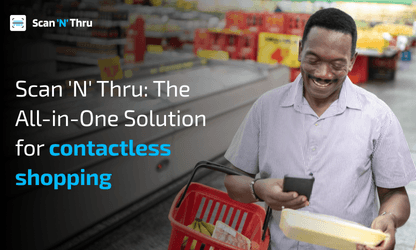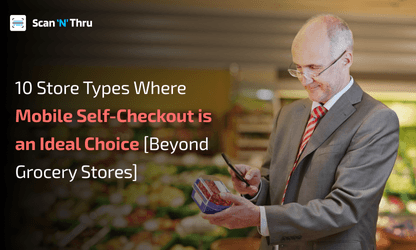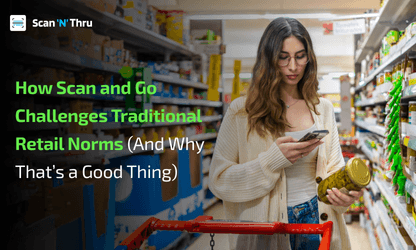Every retail store faces that familiar scene: long lines snaking through aisles, customers shifting impatiently, and staff racing to keep up with the mounting pressure.
These rush-hour challenges stretch beyond mere inconvenience to your customers—they directly impact your bottom line as well through lost sales, reduced efficiency, and diminished customer loyalty.
No doubt, traditional solutions like adding additional checkout counters or hiring temporary staff provide temporary relief. However, they also increase operational costs without addressing the root cause. So what can be done about that then?
Mobile self-checkout offers a different approach to retail store management. By putting the checkout process directly in customers' hands, this technology eliminates queues and reduces operational strain. It is an excellent solution for managing high foot traffic in retail stores.
This blog explores how mobile self-checkout systems help retailers like you turn rush hours from a daily challenge into an opportunity for enhanced customer satisfaction and operational excellence.
You'll discover practical insights into managing peak-time congestion, improving staff productivity, and building stronger customer relationships—all while reducing operational costs.
Let’s begin by understanding how bad store management during peak times can harm your business.
The impact of rush hours on retail store operations
A surge of customers in your store impacts your operations in multiple ways:
Customer experience during peak times
High foot traffic in retail stores is a common sight and it often feels like a test of patience—for both your customers and your staff.
Long queues at checkout counters leave shoppers frustrated; some of them abandon their carts entirely. For instance, John (your customer) walked into your store to grab some quick essentials before his train journey. Now he has grabbed everything he needs in a couple of minutes but he has to wait because there are at least 10 people before him at the checkout counter.
Moments like that not only lead to immediate dissatisfaction but can also tarnish your store’s reputation, which can make customers like John less likely to return.
Beyond the inconvenience, prolonged wait times also fuel a perception of inefficiency, creating ripple effects that harm your brand’s standing among your competitors.
Operational strain on stores
Peak hours place immense pressure on your staff and infrastructure. Checkout counters often become bottlenecks and slow down overall operations. Why?
It’s because your staff members have to deal with multiple tasks, which makes them less productive and prone to errors. Now it’s understandable that as a business owner, you’d want your employees to handle multiple tasks.
However, research suggests that multitasking can lead to up to 40% reduction in productivity and people are likely to make more errors when switching between tasks. Hence, multitasking may look efficient on a surface level, but the bigger picture is that it hampers tasks and productivity.
Apart from that, overcrowded aisles can also lead to inventory mishaps. Your customers may struggle to find products, or shelves may remain unstocked just because your staff members are too busy manning registers. This operational strain disrupts efficiency and also creates a less-than-pleasant shopping environment in your store.
Financial implications of poor rush management
Every abandoned cart represents lost revenue, and during peak hours, these losses can add up quickly. Retailers like you often hire additional temporary staff to manage surges, which increases labor costs without guaranteeing better outcomes.
Plus, consistent poor rush management can lead to long-term damage. It’s because your dissatisfied customers are less likely to return. That is going to impact loyalty and it will reduce lifetime customer value—a critical metric for sustained profitability.
How mobile self-checkout transforms retail store management
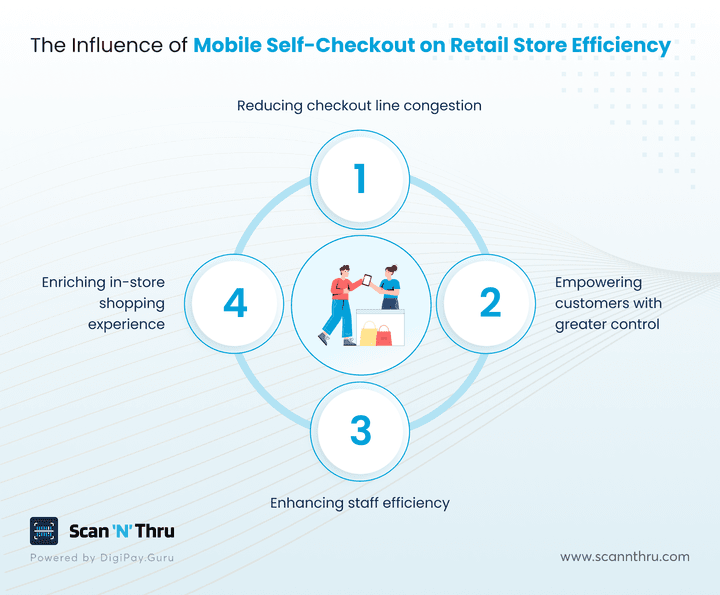
Mobile-based self-checkout can overhaul all your retail operations and store management processes in following ways:
Reducing checkout line congestion
Mobile self-checkout systems turn every customer’s smartphone into a personal cash register. How? Well, these systems enable shoppers to scan, bag, and pay for items directly through an app. Hence, retail stores like yours can virtually eliminate long queues.
With mobile self-checkout technology, instead of watching your customers abandon their purchases during rush hour, you can now serve everyone simultaneously. This turns potential walkouts into satisfied buyers. It's like having unlimited checkout counters without the extra overhead.
Empowering customers with greater control
Mobile self-checkout apps give your customers autonomy over their shopping experience. This means they can shop at their own pace, scanning items as they go without waiting for assistance.
This approach is like allowing customers to "drive" their shopping journey rather than waiting in line for someone else to take the wheel. It is empowering because it makes their trip to your retail shop quicker and more satisfying.
Enhancing staff efficiency
When checkout responsibilities shift to customers, your staff can focus on higher-value tasks like replenishing shelves, assisting shoppers, or ensuring overall store upkeep. This reallocation of duties reduces errors at registers and enhances the shopping environment.
Think of it as deploying your "team players" where they’re needed most, rather than keeping them confined to a single task. It’s a strategy that benefits your store and your customers as well.
Enriching in-store shopping experience
Integrated mobile self-checkout systems provide live inventory updates. This can help guide your customers to alternative products when specific items are out of stock.
Plus, it also prevents the frustration that can arise from wasted trips down empty shelves and ensures customers leave with what they need or a suitable substitute.
Such capabilities are intangible because they help you build trust and show your shoppers that you value their time and effort.
Read more: 5 Reasons Mobile Self-Checkout is a Must for Retailers
Key features of mobile self-checkout systems for managing rush
Mobile self-checkout in your store makes it smarter. Here are the essential features that turn your customers’ phones into powerful checkout solutions:
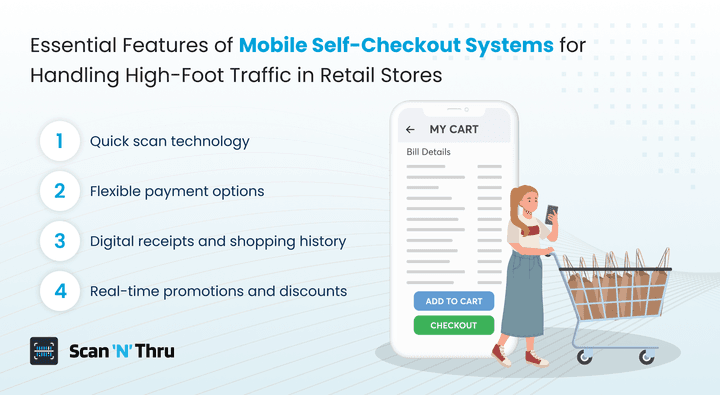
Quick scan technology
Your customers can instantly add items to their cart by pointing their phones at product barcodes/QR codes. No training is needed – if they can take a photo, they can scan the products they need. This ease of use and familiarity means faster adoption and fewer support calls to your staff.
Flexible payment options
Give your customers the freedom to pay their way. Whether they prefer tapping their phone, swiping a card, or using loyalty points, your checkout system handles it all securely. Plus, contactless payments mean faster checkouts during your busiest hours.
Digital receipts and shopping history
Having a mobile self-checkout app means no more paper jams and receipt rolls. Every transaction automatically generates a digital receipt in your customer's app.
Not only does this help in cutting down your operational costs, but it also gives your shoppers instant access to their purchase history. This convenience can convince them to return to your store again.
Real-time promotions and discounts
Mobile self-checkout solutions turn every shopping trip into an opportunity for increased sales. You can adjust your system so that it automatically shows relevant deals to your customers as they shop, right on their phones.
For example, when a regular customer scans their favorite items, they'll instantly see applicable discounts. This can lead to boosting both satisfaction and cart value.
Benefits of mobile self-checkout for retailers during rush hours
Below are some real benefits of mobile self-checkout technology that can help you maintain your store’s efficiency during busy periods:
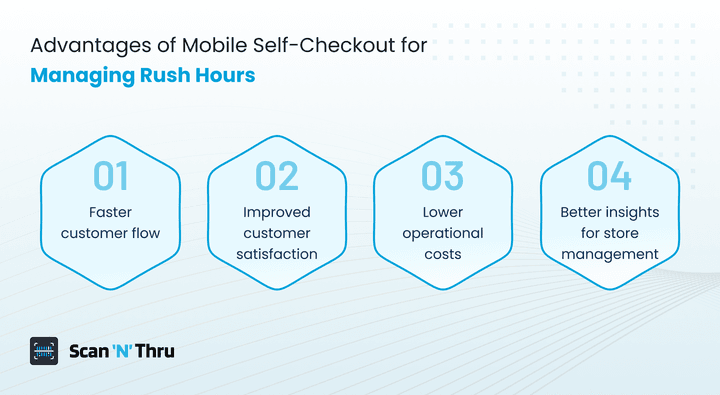
Faster customer flow
By enabling simultaneous checkout for all customers in your store, mobile self-checkout significantly reduces queue times. Shoppers spend less time waiting and more time exploring your store, which leads to a more positive shopping experience overall.
Improved customer satisfaction
When your customers have control over their shopping and checkout process, their satisfaction naturally increases. That also means they’re more likely to associate your shop with efficiency and convenience. The result of that is increased loyalty and more repeat visits.
Lower operational costs
Mobile self-checkout systems reduce the need for additional cashiers during peak hours. In other words, these systems help you cut down your labor costs. Besides, retailers like you can allocate saved resources to improve other areas of your store, like inventory management or customer service.
Better insights for store management
With mobile self-checkout systems, retailers like you gain access to valuable data, such as peak shopping hours, popular items, and purchasing trends. Relaying such information to your store managers can help optimize inventory, staffing, and marketing strategies.
Read more: Mobile Based Loyalty Program to Maximize Customer Engagement
Final words
Managing rush hours effectively requires more than just quick fixes; it demands innovative solutions that cater to both operational efficiency and customer expectations.
You have seen how mobile self-checkout solutions help retailers like you tackle common peak-hour challenges and create a seamless shopping experience for your shoppers.
If you’re looking for tools that you need to thrive during your busiest times then Scan ‘N’ Thru is your best option.
With Scan ‘N’ Thru, you can:
- Streamline checkout processes: Customers can scan items and pay via their smartphones, skipping long queues.
- Access real-time inventory updates: Avoid stockouts and enhance shopping satisfaction.
- Leverage loyalty integration: Offer personalized rewards and discounts that keep shoppers coming back.
- Provide instant digital receipts: Reduce paper waste and improve post-purchase convenience.
- Enhance operational efficiency: Free up staff to focus on customer service instead of manning registers.
Rush hour doesn’t have to mean chaos. By adopting Scan ‘N’ Thru, you can turn peak times into opportunities to leave a positive impression on your customers, boost sales, and stay ahead of your competitors.


